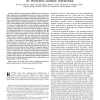Free Online Productivity Tools
i2Speak
i2Symbol
i2OCR
iTex2Img
iWeb2Print
iWeb2Shot
i2Type
iPdf2Split
iPdf2Merge
i2Bopomofo
i2Arabic
i2Style
i2Image
i2PDF
iLatex2Rtf
Sci2ools
104
click to vote
TON
2012
2012
Exploiting Data Fusion to Improve the Coverage of Wireless Sensor Networks
Abstract—Wireless sensor networks (WSNs) have been increasingly available for critical applications such as security surveillance and environmental monitoring. An important performance measure of such applications is sensing coverage that characterizes how well a sensing field is monitored by a network. Although advanced collaborative signal processing algorithms have been adopted by many existing WSNs, most previous analytical studies on sensing coverage are conducted based on overly simplistic sensing models (e.g., the disc model) that do not capture the stochastic nature of sensing. In this paper, we attempt to bridge this gap by exploring the fundamental limits of coverage based on stochastic data fusion models that fuse noisy measurements of multiple sensors. We derive the scaling laws between coverage, network density, and signal-to-noise ratio (SNR). We show that data fusion can significantly improve sensing coverage by exploiting the collaboration among sensors when several ...
Fusion Algorithms | Programming Languages | Synthetic Data Sets | TON 2012 | Wireless Sensor Networks |
Related Content
| Added | 28 Sep 2012 |
| Updated | 28 Sep 2012 |
| Type | Journal |
| Year | 2012 |
| Where | TON |
| Authors | Rui Tan, Guoliang Xing, Benyuan Liu, Jianping Wang, Xiaohua Jia |
Comments (0)

